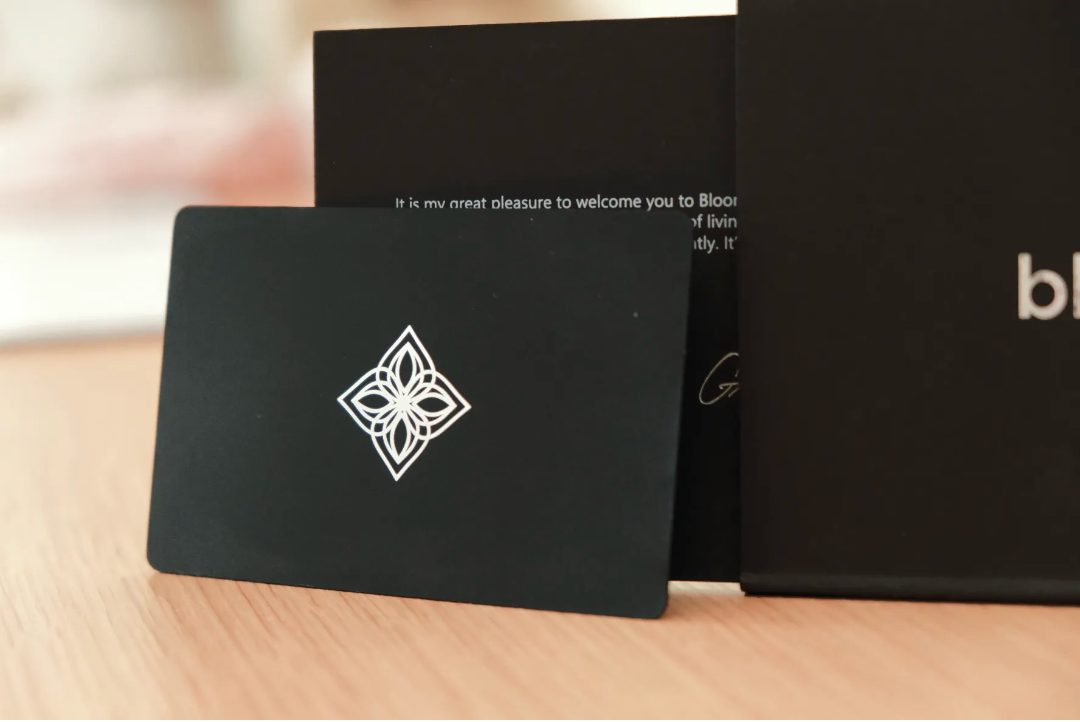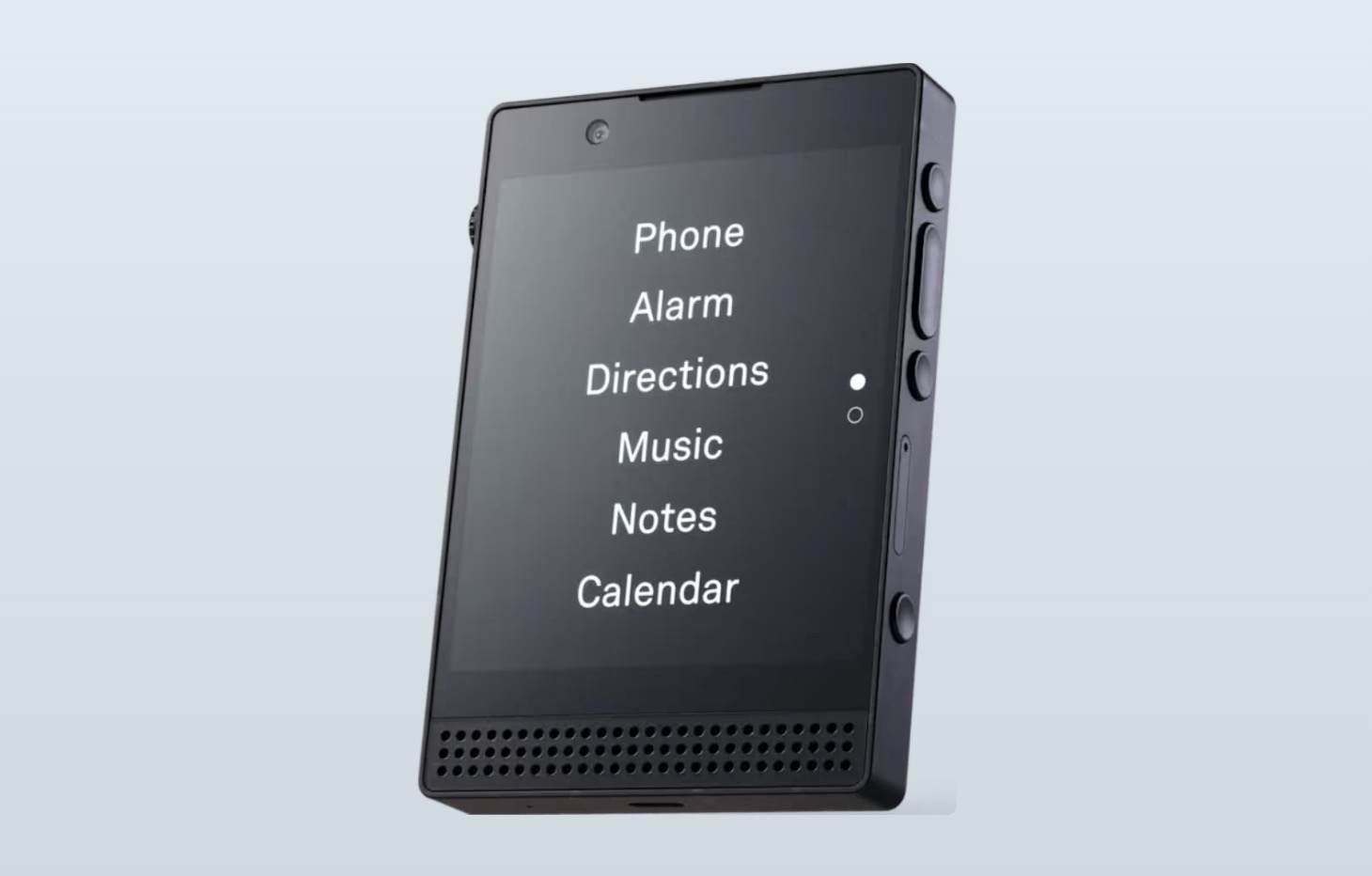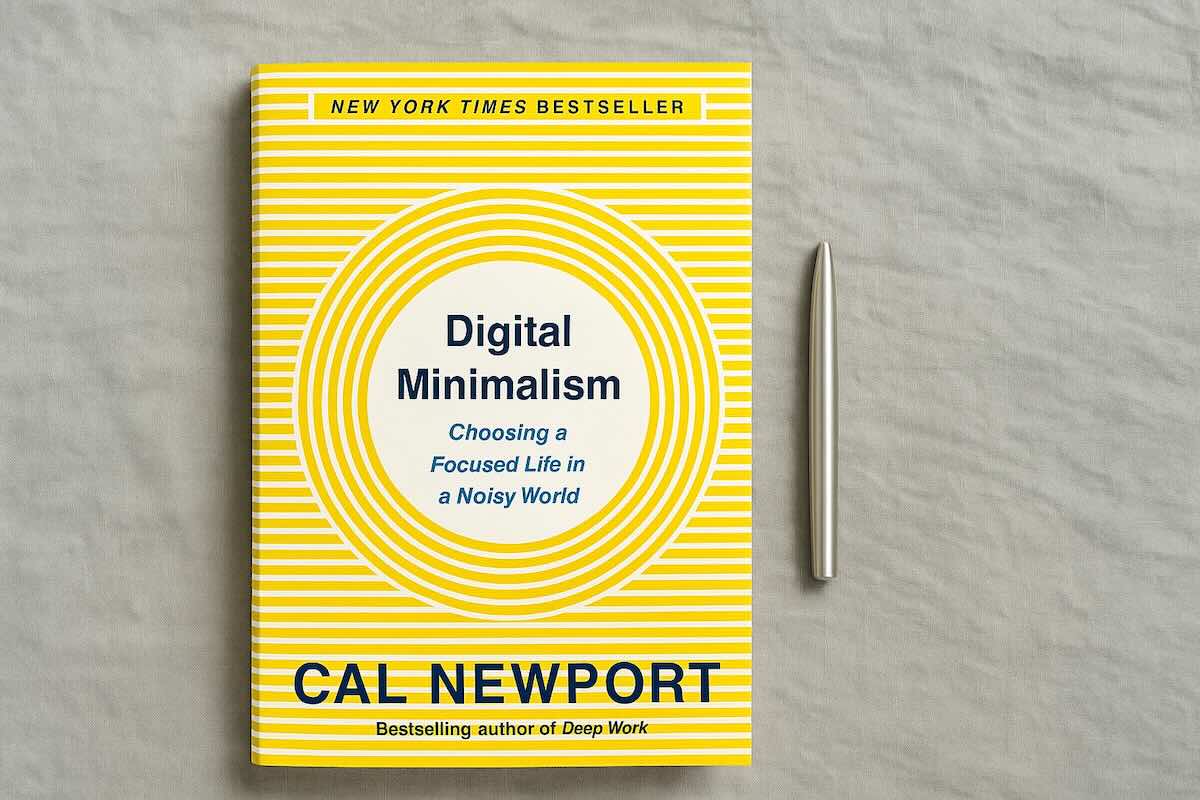One bag travel is a style of travel that involves carrying a single carry-on size bag. Nothing less. Nothing more.
In this post, you'll discover some of the One Bag best practices and hacks.
You'll read reviews of the best travel bags available today and learn how to pack efficiently. You'll also be able to download a sample one bag packing list, customize it, and use it on your next getaway.
Let's jump right in and look at the benefits of one bag travel.
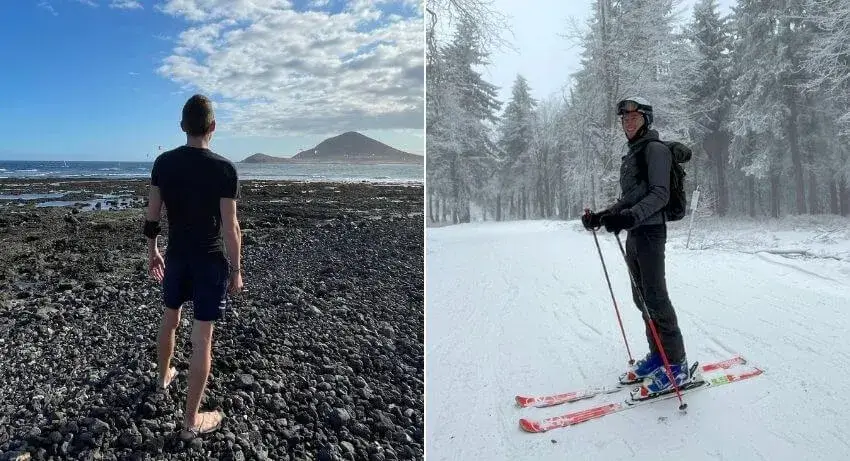
Want to Breeze Through This Post?
Best One Bag Travel Backpacks
If you're serious about one bagging, you'll want to invest in a great travel backpack that is lightweight, carry-on friendly, and packs effectively. Here are four popular options to consider:
Heimplanet Transit Line: Sleek, comfortable, and durable travel backpack made by German company Heimplanet. Best for Europeans looking to avoid hefty import fees and costly shipping. I've owned this backpack for 2+ years and rely on it for all my international travels. I love how spacious and practical it is.
[Use code whatifididnt15 at checkout to get 15% off the Transit Line 34L.]
Tortuga Setout Divide 26L: One of the most popular backpacks for one bag travel. Sleek and well-built, but slightly heavier than the competition. It can expand to 34L.
Aer Travel Pack 2: Incredible design, quality, and comfort. Lots of well-thought-out pockets and compartments.
Osprey Farpoint 40: Best if you don't travel with a laptop. The pack has a laptop sleeve, but it's at the front of the pack.
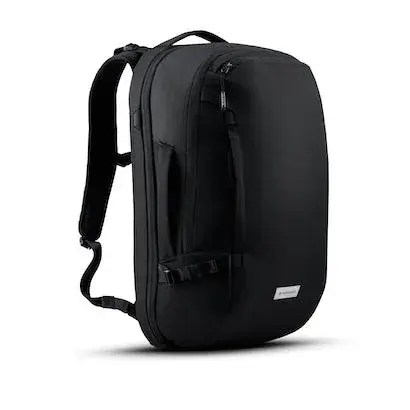
Backpack Considerations
Although messenger bags, briefcases, and wheeled luggage qualify as "one bags", the One Bagger's luggage of choice is a backpack.
Here are a few things to consider when shopping for a great travel bag:
Size: 30L to 40L as a Starting Range
Travel backpacks can range anywhere from 8L (Aer Slim Pack) to 40L (Osprey Farpoint 40). Anything above that and you risk exceeding the allowed carry-on size for most airlines.
The size you choose will depend on how light you want to pack and what airline you're flying with. (Restrictions in Europe are slightly different than in America, for instance.)
If you're new to one bag travel, start with a pack in the 30L to 40L range. Then work your way down as you optimize your gear and learn to pack more efficiently.
| Airline | Max. Carry On Size | Max. Carry On Weight |
|---|---|---|
| Southwest | 24 x 16 x 10 in | None |
| Delta | 22 x 14 x 9 in | None |
| American Airlines | 22 x 14 x 9 in | None |
| United | 22 x 14 x 9 in | None |
| British Airways | 22 x 18 x 10 in | 51 lbs |
| JetBlue | 22 x 14 x 9 in | None |
| Lufthansa | 21 x 15 x 9 in | 18 lbs |
| EasyJet | 18 x 14 x 8 in* | None |
*: Larger cabin bags (22 x 18 x 10 in) are allowed for an additional fee
Opening: Front-Loader vs Top-Loader
Top-loaders are packed from the bottom up. This means you'll have to take everything out of the bag to take out the jacket you stuffed at the bottom of your pack. Top-loaders tend to be lighter than front-loaders.
Front-loaders, also known as clamshell backpacks or panel loaders, let you unzip and open the entire front panel of the pack. Like a suitcase. This type of backpack is more popular for travel because you can easily access any part of the bag without having to take anything out.
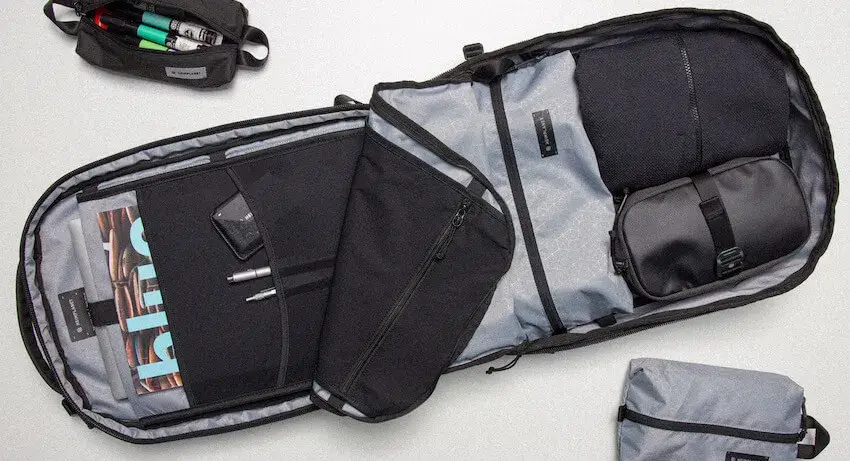
Tech Compartment: What to Look For
If you plan on traveling with a laptop, make sure to look for a bag with a laptop sleeve.
The laptop sleeve should be slightly padded, elevated a few inches from the bottom of the pack, and located closest to your back. This will ensure your computer is protected when you accidentally bump it into something or drop it on the ground.
Want more productivity tips, tools, and hacks?
Join 250+ readers by signing up for our newsletter.
Sent once a month. See previous editions.
Sample One Bag Packing List
The following packing list gives you an idea of what will fit inside a 30L travel backpack. Download it and customize it as you please (File -> Make a Copy to edit).
Clothing
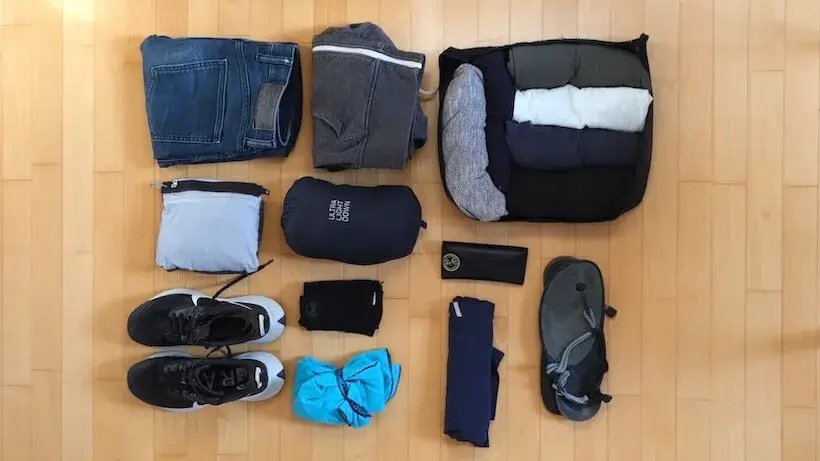
- 4 t-shirts (plain shirts in neutral colors like white, black, navy, brown, or khaki go with everything)
- Hoodie (your go-to lounge and travel wear)
- Sweater (for more dressy occasions like a night out or a date)
- Pair of shorts (skip if you're going somewhere cold)
- Pair of pants (jeans or chinos in neutral colors are the most versatile options)
- Bathing suit (for men, a pair of board shorts can double as workout shorts)
- Long-sleeve base layer (to sleep in or to layer in cooler climates)
- Pair of long underwear or tights (to sleep in or to layer in cooler climates)
- 4 boxer briefs (invest in moisture-wicking, breathable underwear)
- 4 pairs of socks
- Rain jacket or poncho (to protect against rain but also wind)
- Down puffy (down feathers are lightweight and incredibly warm compared with synthetic fill)
- Pair of Sneakers(all-purpose shoes, including working out)
- Pair of Sandals (minimalist sandals pack small and weigh close to nothing)
- Buff (can be used as a neck gaiter, beanie, sleep mask, travel pillow, and much more)
Toiletries
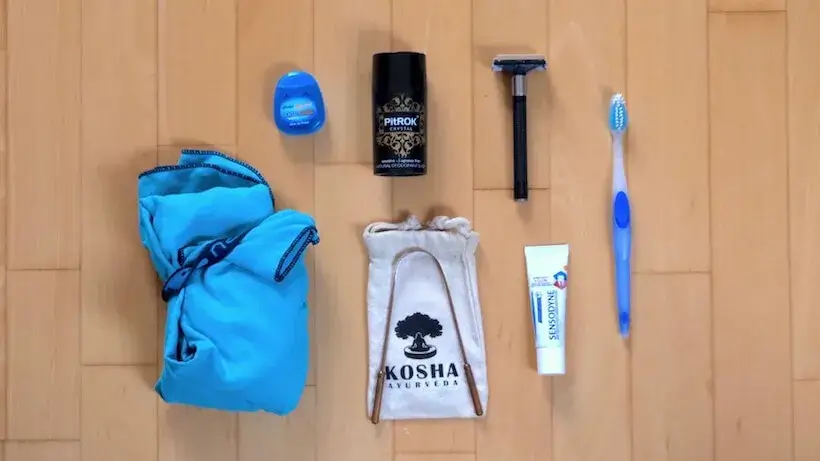
Most places you'll visit will have shower gel, cotton swabs, and sunscreen readily available. Purchase those upon arrival. Your toiletry kit doesn't have to be much more sophisticated than this:
- Toothbrush
- Toothpaste
- Towel (use it at the beach or between washes if your Airbnb or hostel doesn't provide extras)
- Deodorant (solid deodorant can stay in your bag during airport screenings)
- Floss (can be used in a pinch for stitching ripped clothes or as a travel clothesline)
Store everything inside a ziplock bag or a lightweight pencil case.
Tech (Optional)
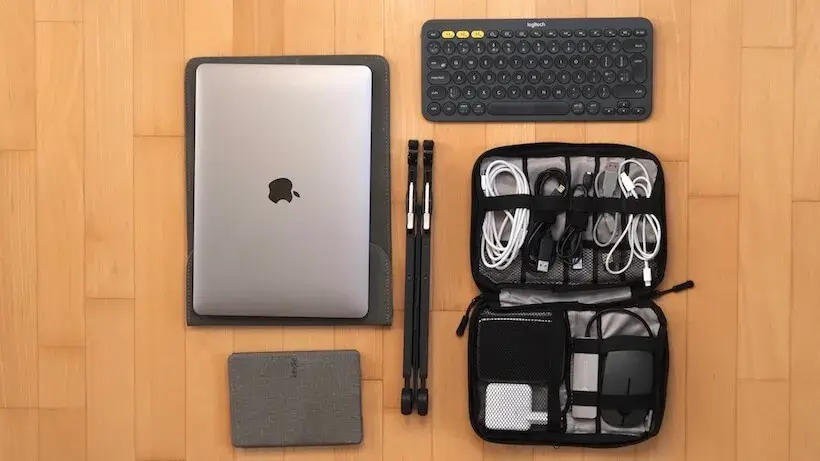
This section only applies if you plan to work while abroad. This is going to be the heaviest gear in your bag, so leave it at home unless you truly need it.
- Laptop
- Tech bag (keeps all the cables neatly organized)
- Chargers
- Extras: mouse, keyboard, laptop stand, power bank, tablet, etc.
First Aid Kit
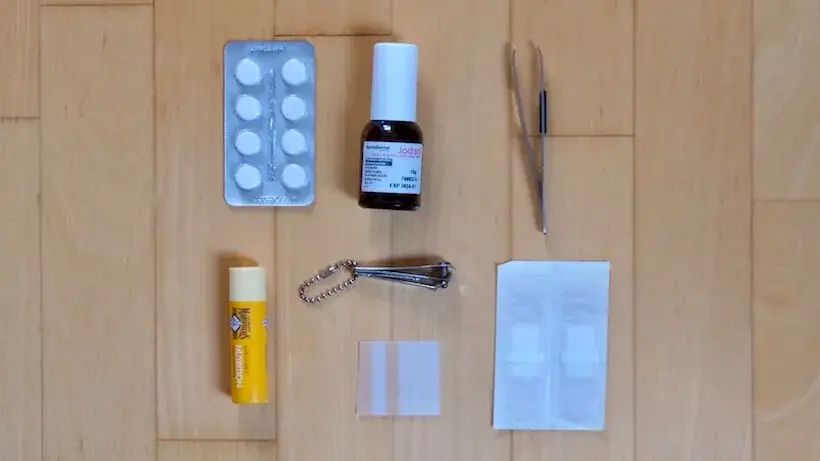
A lightweight first aid kit is essential for travel peace of mind. Here's are some basics:
- Bandaids (for cuts and scrapes)
- Butterfly bandages (for bigger wounds)
- Antiseptic solution
- Anti-inflammatory (ie Ibuprofen)
- Tweezers (for splinters, broken glass, etc.)
- Nail clippers
- Lip balm or vaseline (apply to hotspots to reduce friction and prevent blisters)
Packing Tips
Still thinking: "No way I can travel with only one bag"? This section is for you. These 9 tips will help reduce your load and pack everything in one bag.
1. Use packing cubes: Packing cubes (stuff sacks work too) compress your pack's content but also make your pack incredibly tidy. You won't need more than 3 cubes: a medium-sized cube for your clothes, a small-sized cube for your underwear and socks, and another small cube for anything that remains like your jacket, towel, or neck warmer.
2. Roll, don't fold: Rolling clothes saves space. It'll also prevent your clothes from getting wrinkled. Shirts, pants, underwear... roll it all!
3. Buy it there: Unless you're traveling to a remote destination, there is no need to take your umbrella, deck of cards, sunscreen, headlamp, and cough syrup. In the off-chance you do end up needing them, you can purchase them on site. You can also rent pricier items like surfboards, guitars, and climbing shoes for cheap.
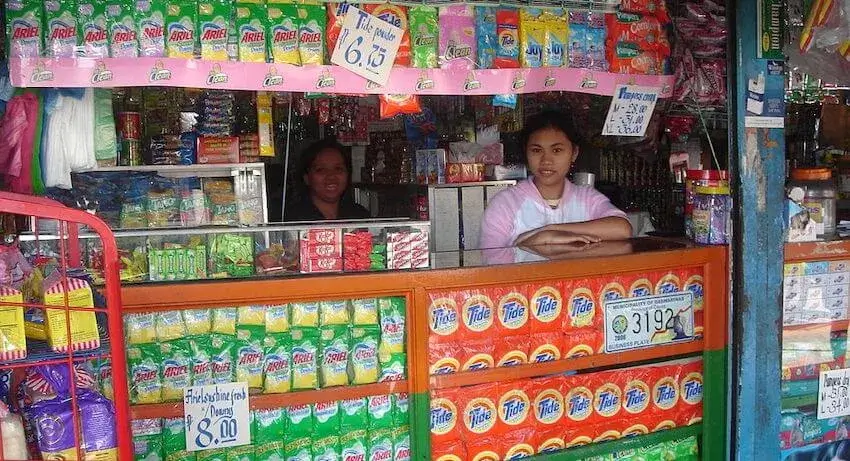
(Photo: Sari-Sari Store in Cavite, the Philippines by Glen | Wikimedia | CC BY 2.0)
4. Choose fabrics wisely: Because you'll be traveling with fewer clothes, choose items that give you the most bang for your buck. For example, polyester and merino wool breath better and dry faster than cotton. And down is incredibly warm yet lightweight compared to synthetic insulation.
5. Use cases: Choose versatile items when possible. A Buff can serve as a beanie, eye mask, neck gaiter, or pillowcase. Your swim trunks can be used as workout shorts. A trash bag can serve both as a dirty laundry bag and as a pack liner to protect your pack's content from the rain.
6. Wear the heavy and bulky: Wear your bulk and heavy items when traveling. That includes shoes, belts, hats, jackets, etc. That way, you take some of the load off of your back and create additional space in your pack. Naturally, don't overdo it. If you're wearing a sweater in 100-degree weather, you're doing it wrong.
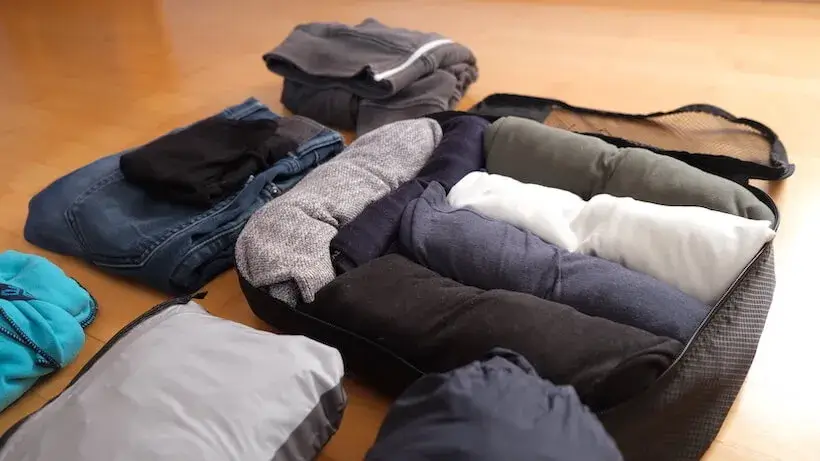
7. Stuff hollow items: If you carry an extra pair of sneakers in your pack, stuff them with clothes to utilize every inch of space and get rid of the extra space. The same goes for hats.
8. Get a day bag (maybe): If you're going on a day trip, you may not want to carry around that bulky 30L bag around. Instead, invest in a foldable and lightweight day bag that you can roll up and stuff at the bottom of your primary pack. 10L should be plenty to fit a rain jacket, water bottle, and a few snacks.
9. Optimize further: Lay out all of your clothes and gear onto the floor prior to putting it inside your bag and look for further optimization. Any duplicate items? Unnecessary pouches and covers? Maybe your headphones can be replaced by a pair of earbuds, your electric shaver by a disposable razor, and your 2m USB-c cable by the 1m version.
Why One Bag Travel?
The benefits of one bag travel far outweigh the inconvenience of leaving a DSLR camera at home or not being able to fit 2 kg of duty-free goodies inside your pack. Here are the top 6 reasons the One Bag lifestyle is so appealing:
Travel Light: No lifting, pulling, and tossing luggage around. One bag travel keeps your hands free, your load light, and your feet at ease.
Never Lose Your Bags: No checked bag means no chances of getting your belongings misplaced, stolen, or damaged.
Avoid Pickpockets: Nothing screams "tourist" more than your shiny Samsonite suitcase. And guess who loves tourists: pickpockets and con artists.
Save on Luggage Fees: When did checked bags get so expensive? On short-haul flights, the cost of a checked bag is often greater than the plane ticket itself.
Breeze Through Airports: Skip the check-in line and shrug your shoulders at the baggage carousel. Last in, first out.
Live More Intentionally: There is something weirdly satisfying about a neatly-organized bag where each item has had to fight for its place on the trip.
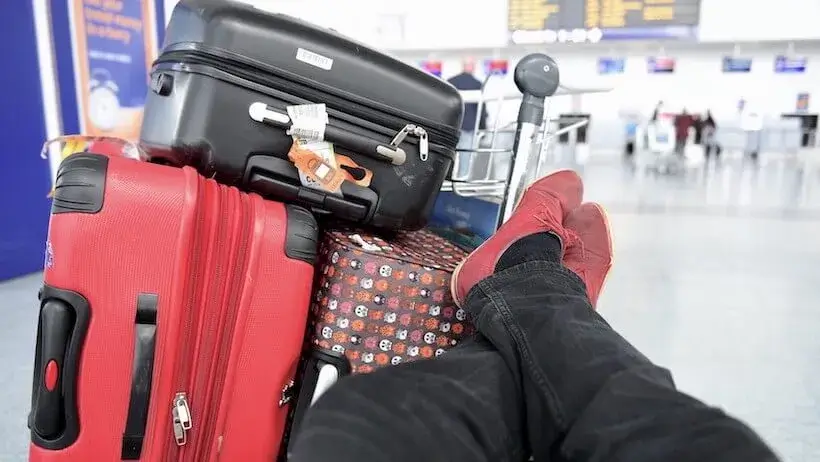
FAQ
How do I do laundry?
In other words: "How do you live off of 4 shirts and 4 underwear without smelling like a skunk?"
If you have a washing machine or laundromat at your destination, you'll do laundry once a week and wash your underwear by hand once between each laundry cycle.
There are several ways to hand wash:
- Shower with your clothes
- Put your clothes in a dry bag with water and a dash of laundry detergent (or shampoo). Shake it for 10 minutes. Then rinse and dry.
- Use a sink stopper to fill a sink with water. Add a bit of soap. Agitate your clothes in the water for 10 minutes. Then rinse and dry.
How to Travel with One Bag in Cold Weather?
In cold weather, you might be tempted to pack a thick winter jacket, snow pants, and heated mittens to stay warm. But don't.
Instead, think in layers. The colder it gets, the more layers you stack on top of each other.
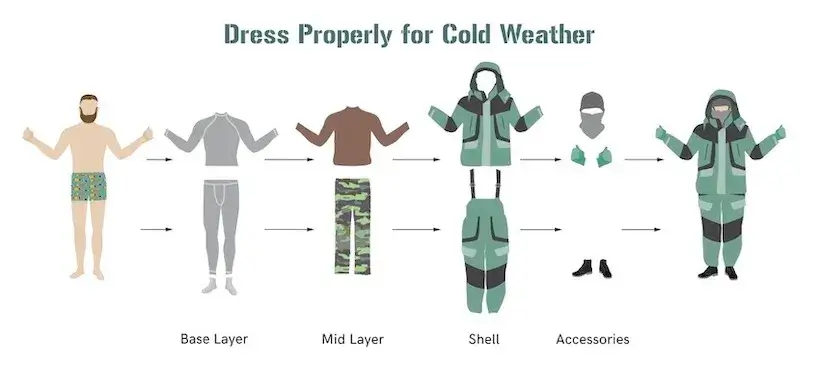
First, you'll want a moisture-wicking base layer made of wool or polyester. Next, a mid-layer made from an insulating material like fleece or down. And last, a waterproof and windproof layer made of DWR-treated nylon or GORE-TEX.
The layering principle applies to the upper body, lower body, and extremities (ie. head, feet, hands).
Here's how you might use this:
- Upper body: Stack a long-sleeve merino wool shirt with a sweater, down jacket, and rain shell
- Lower body: Add a pair of tights underneath your chinos or jeans
- Head and neck: Wear your Buff neck warmer as a balaclava and stack a hoodie on top
One Bag Weight?
Your bag should weigh between 10 lbs and 20 lbs. Anything above 20 lbs and you start to lose some of the benefits of efficient and minimal packing. Also note that in Europe, most airlines won't allow carry-ons heavier than 10 kg (22 lbs).
A big shoutout to Reddit’s r/onebag community for all the amazing tips and resources they’ve made available!
Full disclosure: When you buy a product through our links, we may earn a small commission. This helps us keep going, and it won't cost you a penny. Thanks for backing us.

